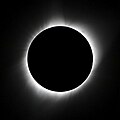| Total eclipse | |
 Partial from Gisborne, New Zealand | |
| Gamma | −0.3132 |
|---|---|
| Magnitude | 1.0237 |
| Maximum eclipse | |
| Duration | 120 s (2 min 0 s) |
| Coordinates | 37°48′S173°36′W / 37.8°S 173.6°W |
| Max. width of band | 85 km (53 mi) |
| Times (UTC) | |
| Greatest eclipse | 22:54:17 |
| References | |
| Saros | 142 (21 of 72) |
| Catalog # (SE5000) | 9475 |
A total solar eclipse occurred at the Moon's descending node of orbit between Thursday, November 22 and Friday, November 23, 1984, [1] with a magnitude of 1.0237. A solar eclipse occurs when the Moon passes between Earth and the Sun, thereby totally or partly obscuring the image of the Sun for a viewer on Earth. A total solar eclipse occurs when the Moon's apparent diameter is larger than the Sun's, blocking all direct sunlight, turning day into darkness. Totality occurs in a narrow path across Earth's surface, with the partial solar eclipse visible over a surrounding region thousands of kilometres wide. Occurring about 2.1 days after perigee (on November 20, 1984, at 20:50 UTC), the Moon's apparent diameter was larger. [2]
Contents
- Observations
- Eclipse details
- Eclipse season
- Related eclipses
- Eclipses in 1984
- Metonic
- Tzolkinex
- Half-Saros
- Tritos
- Solar Saros 142
- Inex
- Triad
- Solar eclipses of 1982–1985
- Saros 142
- Metonic series
- Tritos series
- Inex series
- Notes
- References
Totality was visible in Indonesia, Papua New Guinea and southern Pacific Ocean. West of the International Date Line the eclipse took place on November 23, including all land in the path of totality. A partial eclipse was visible for parts of Indonesia, Australia, Oceania, Antarctica, and extreme southern South America.







































































































